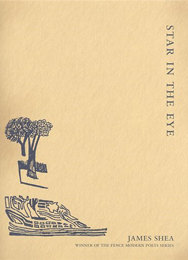Review: STAR IN THE EYE by James Shea

Review by JESSICA FORDHAM KIDD
The straightforward idiom in James Shea’s Star in the Eye can be deceptive at first. Taken piece by piece, the images of each poem seem so right and precise that I almost forget to investigate the strange leaps taking place within the entirety of each work and within the book as a whole. While contemporary poetry often toys with randomness or the creative collisions of picture and sound, this collection doesn’t feel like part of that project. The disconnect in Shea’s poems feels coherent—like there is a rhyme and reason to the movement from bathing in the sun to avoiding a rug with live birds sewn in.
The book’s reliance on dreams and elemental motifs creates this unconventional coherence. While some leaps may be surreal, they don’t ever feel out of character. Water and sky are appropriate motifs for a book that deals with dream and death and language; there is an uncertainty and changeableness that the book explores in all those forces. Shea writes:
I drove with my jeep to the beach.
The waves in general were special to me.
I saw them all for a moment at a time.
The two boys woke to their deaths.
They could not give up more.
There is no rhetoric of a storm.
The natural elements become part of the more human landscapes of dreaming, dying, and speaking; they become indistinguishable.
Shea’s book has, in my opinion, four very appealing strengths: a beautiful, uncomplicated language to deal with its uneasy movement from image to image, an ability to touch on the dire without getting lost in it or losing a sense of humor, judicious use of the short form, and a willingness to interrogate language.
The short form is displayed best in poems made of a series of tiny sections. “The Riverbed” is composed of 45 brief parts. In the section titled Crossing the Riverbed, “The duck/ Plays with the river–/ Knowing it could fly.” In Revised Riverbed, “ A man feeds his penis/ To the fish.” Shea certainly runs the gamut here. All of the book’s themes and preoccupationsfind outlet in this collection within the collection.
This poem is also an excellent example of how Shea borrows from the sensibility of haiku. Again, the simplicity is deceptive. The short section so quickly read deserves another look.
There are other poems that use small sections to comprise a larger whole and these poems along with works like “Storms” and “Haiku” which employ form to call attention to writing and language are the backbone of the book. They take on a light of their own. Some other poems in the collection too easily fade into the background; they carry the motifs and employ their beautiful language, but without being especially memorable. Perhaps these pieces are a necessary backdrop to the sharper moments in the book. And Shea’s Star in the Eye does have a satisfying number of those moments.